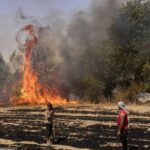Elazığ is a city in Eastern Anatolia / North Kurdistan founded in and around the former city of Harput, which was largely destroyed during the Armenian genocide during World War I. The city sits on a plain at an altitude of 1,067 metres (3,501 ft) in the uppermost Euphrates valley and resembles an inland peninsula surrounded by the natural Lake Hazar and reservoirs of a number of dams.
In the late 19th and early 20th century, Elazığ exported raisins, apricots and almonds to Europe. Opium was also grown in the area. Honey was also produced, but not so much exported, but used by locals. Gold was also found in the area in the early 20th century.
The town was captured by Kurdish rebels during the Sheikh Said rebellion against the government of Atatürk in 1925. It was used as a base of operations by the Turkish Army during the Dersim uprising and subsequent massacre.
More than 30,000 people and at least 212 villages were affected by the construction of the Keban Dam in 1966–1974, which flooded several formerly populated areas.
Today, Elazığ is the capital of the Elazığ Province; a busy city with a university and an industrial base. Elazığ is considered the most developed city (and province) in the region.
Elazığ is also known for its vineyards, and two types of grape varieties Öküzgözü and Boğazkere. The state-run vineyards of Elazığ are notable for its production of Buzbağ, a full-flavored red wine.
The city’s population was officially registered as 387,072 in 2022.

